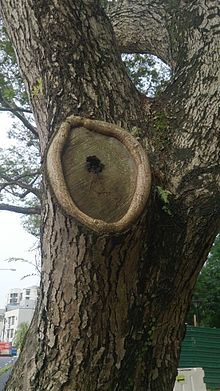Bark pocket

Bark pockets are patches or inclusions of bark partially or fully embedded in the wood of a tree. They can also be used as biomonitors. Bark pockets are considered a nuisance in the lumber industry because they are considered a defect, and lower the grade of the wood.[1] Bark pockets can also weaken tree forks, and can result in damage to the junction under stress.[2]
Formation
[edit]

Bark pockets can be formed by inosculation, formation of a tree fork, encapsulation of a branch, joining together of an uneven trunk, or encapsulation of another object.[3][4] During inosculation, the bark trapped between the two joining trunk becomes surrounded with wood once the trunks fuse. The resulting bark pocket formed during inosculation or in a tree fork is referred to as included bark.[citation needed]
When a branch is encapsulated, the outer bark on the branch may remain inside the wood of the tree, as the trunk widens and grows around the branch.[citation needed]
As biomonitors
[edit]Bark pockets can be used as an indicator of air pollutants during which the time they formed.[3]
They can be used to monitor heavy metals such as lead and copper, as dust or other matter deposited on the bark at the time of formation is still present.[5][6]
One study analysed the amount of polycyclic aromatic hydrocarbons (PAHs) present in bark pockets as a historical record of air quality, possible due to the interaction between PAHs and lipids in the bark.[7]
References
[edit]- ^ Veneer Grading
- ^ Hazards From Trees
- ^ a b Tree "bark pocket" as pollution time capsule for historical monitoring.
- ^ Knots, Burls, and Bark Pockets
- ^ Monitoring of heavy metals in airborne particles by using bark samples of japanese cedar collected from the metropolitan region of Japan.
- ^ Utilization of bark pockets as time capsules of atmospheric-lead pollution in Norway.
- ^ Wang, Qiuquan. "Historical Records of Airborne Polycyclic Aromatic Hydrocarbons by Analyzing Dated Corks of the Bark Pocket in a Longpetiole Beech Tree". Environmental Science & Technology. 38: 4739–4744. doi:10.1021/es049685j.
